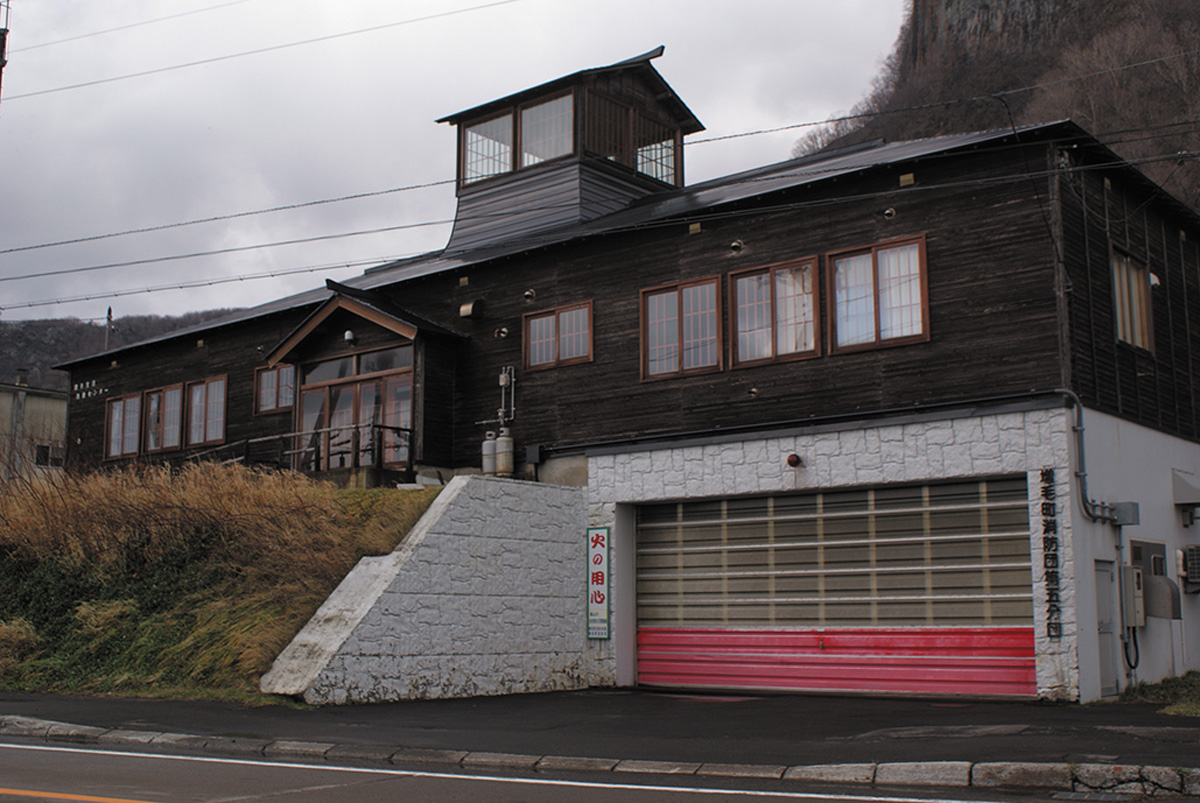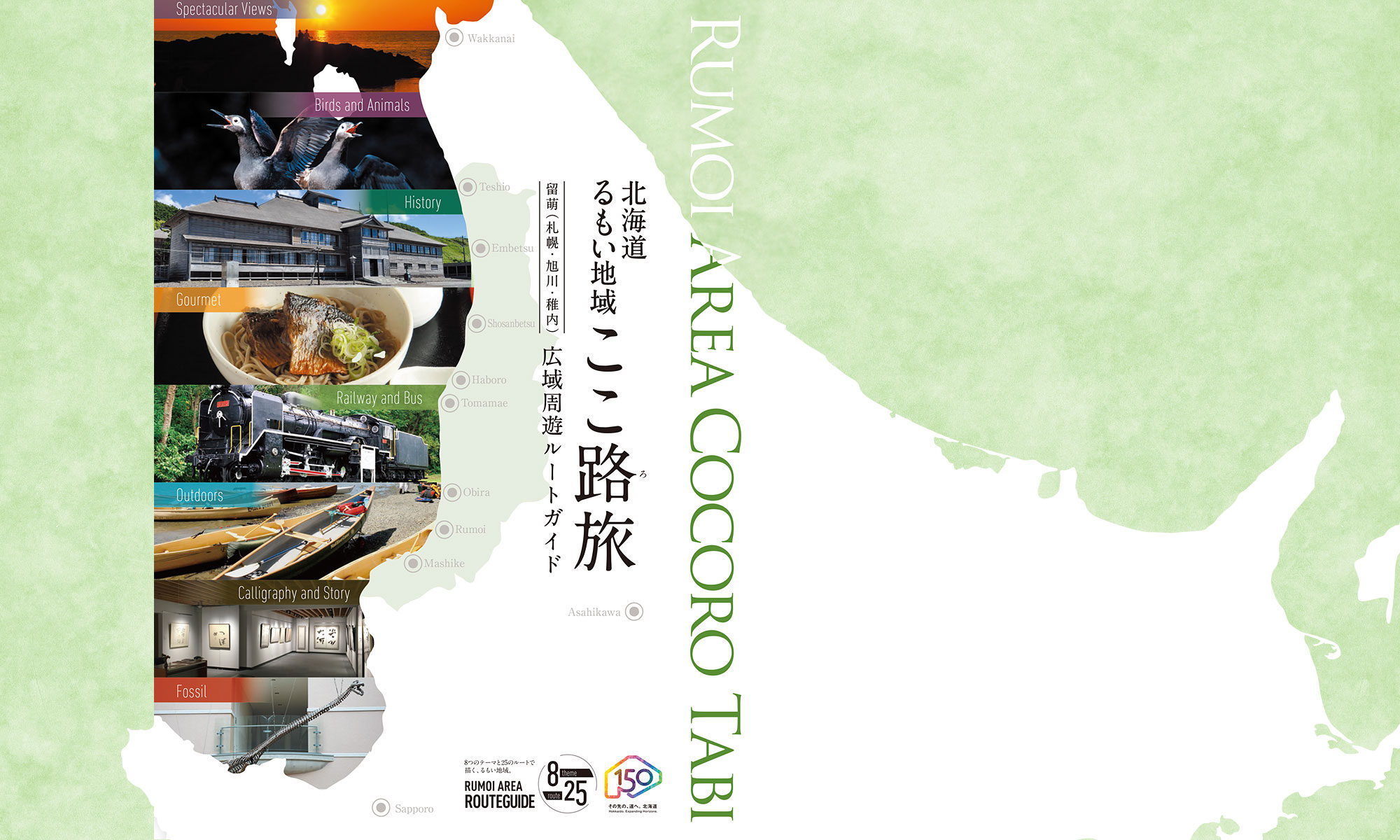㊸Former Tanaka Family Fishermen’s Branch Lodge(Afun, Mashike)
The remains of this lodge are located 6 km out of Rumoi on the way to Mashike. The lodge building itself was moved to Spain in 1994 and the remaining foundation can only be viewed from outside the premises.

㊶Former Rumoi-Saga Family Fishing Ground(Reukecho, Rumoi)
The Saga banya is located in Reuke, Rumoi along National Route 231. The area where ground herring was dried and the galvanized iron-clad warehouse can be seen to the left. A boat shed and the Inari Shrine stand on the hill behind.
The hearth where herring was boiled can be clearly seen on the shore across the highway from the banya.
The 3,745 items of fishing tackle stored here were designated as Important Tangible Folk Cultural Properties of Japan. The site was chosen as a Registered Historical Property of Hokkaido. The grounds are temporarily open to the public in the summer.
Address / Reukecho, Rumoi
TEL.0164-42-0435(Rumoi City Education Board)
This site can only be viewed from outside the premises.
A Key Industry – What does this historic spot tell us about herring fishing?
The reason the herring boom, which lasted from the Edo era (1603~1868) to the beginning of the Showa era (1926~1989), was the basis of so much prosperity is something more complex than simply the netting and transporting of fish. Rather than food, herring was more importantly used as fertilizer for cotton and the mulberry trees, which were raised to feed silkworms for silk. A huge workforce was hired to net the herring, and then boil them in huge cauldrons to make herring meal. This meal was then shipped throughout Japan. The herring industry was key to the financial foundation of Hokkaido.
In order to understand the scale of the herring boom era one must visit the Saga Family Fishing Grounds in Reuke, Rumoi. It is an invaluable representative landmark of the herring boom era in Hokkaido. This complete fishing site is composed of the banya, the galvanized iron warehouse, a boat shed, a net shed, the passage where fresh herring were temporarily stored, and the Inari Shrine. Along the coast across the road, you can still see where the hearth for boiling herring was and the well-preserved boat launch. The over 3500 items of fishing tackle stored here were designated as Important Tangible Folk Cultural Properties of Japan. This site was also recognized as Heritage of Industrial Modernization by the Ministry of Economy.

㊺Sengoku-gura
This warehouse was built with imposing solidity. It stands slightly toward the sea from the (former) Maruichi Honma mercantile.
(left) The boat that is displayed inside was designed in the Mashike signature darumahagi style. The paint is vivid even still on this well-preserved fishing boat of yore.
Address / Inabakaigancho 53, Mashike
TEL.0164-53-1050 (Kunimare Sake Brewery)
Open hours / 10:00-17:00
Admission Fee / Free
Closed in winter
The (former) Maruichi Honma Family left a legacy of Herring Fishing
Murayama Denbei became a merchant after arriving at Matsumae from Noto no Kuni (Ishikawa Pref.). In 1750 he became a contractor and opened fishing grounds in Rumoi and Mashike. Rumoi and Mashike then entered into an era of unprecedented prosperity supported by the herring boom. Many people were drawn to the prominent fishing grounds in Mashike, which then became the center for commerce in Nishi-Ezo.
The Maruichi Honma family amassed considerable resources during this period and continues to be a prominent influence in Mashike today. The Kunimare Sake Brewery carries on the family business legacy, which once also included clothing and variety goods. The Honma family also dealt in the herring industry; Sengokugura was their warehouse. It once housed fishing tackle but when the port was enlarged in the Taisho era, it was moved to its current location. The exact date of construction is unclear but it is estimated to be around 100 years ago. Sengokugura is open to the public for free observation in the summer only. A fishing boat and tackle is on display inside. There is a seasonal café there and the large space is used as an event hall.
㊹Former Ishida Family Fishermen’s Lodge (Afun, Mashike)
When you turn left off National Route 231 onto Hokkaido Route 94, you will see a red-roofed banya. It was built in the middle of the Meiji era and is still used as a private home. It can only be viewed from outside the premises.
㊻Former Date Family the Secondary Fishermen’s Lodge(Bekkari, Mashike)
The remains of this banya are located near the Engan Bekkari bus stop, or a 15 minute walk away from the Bekkari fishing port. It was built in 1931 and is the current location for Ihara Marine Products. It ca only be viewed from outside the premises.

㊼Former Takahashi Family Fishermen’s Lodge(Ofuyu 43-1, Mashike)
This banya is located on the boundary between Ofuyu, Mashike and Hamamasu, Ishikari. It has been remodeled as the community center of Ofuyu and also houses the fifth division of the Mashike fire department. It can only be viewed from outside the premises.
This is the view from the outside of the (former) Takahashi Family banya/Ofuyu Community Center. The firehouse garage beneath the staircase is an interesting feature of this remodeled banya.

